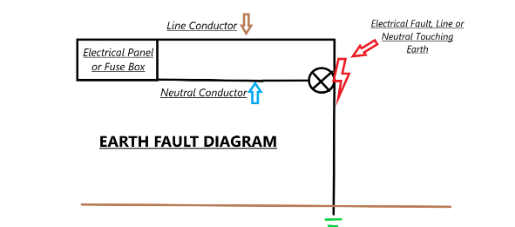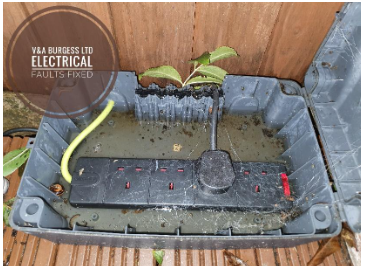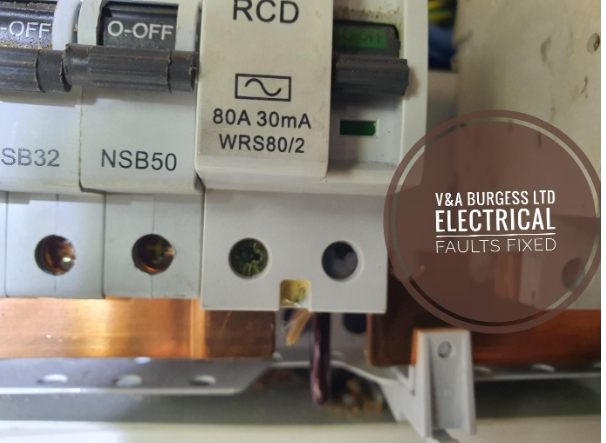1) What is a healthy circuit?
A healthy circuit is one which contains a safe amount of electrical current flowing that does not exceed the intended design of the circuit, creates no excess heat and carries no risk of overload or electric shock.
A healthy electrical circuit will often contain various switches, plug socket outlets, appliances or other electrical loads and will safely be able to supply those electrical loads and cope with the demands placed upon it.

We can see from the diagram above that our electrical circuit begins at the electrical panel, consumer unit or fuse box and contains an electrical load like a light bulb or lamp. The electrical current flows down the Line conductor through the electrical load and back down the Neutral conductor.
The electrical current is not excessive, poses no danger of electric shock and creates little excess heat beyond the intended design of the circuit or equipment connected to the circuit.
Everything is happy!
Back to top2) What is a Short Circuit?
When considering a SHORT CIRCUIT VS GROUND FAULT, a short circuit is an unintended connection between the Line and Neutral (or hot and neutral) conductors in an electrical circuit. These wires can be thought of as the flow and return of electrical current. For a circuit to operate in a healthy and safe manner, there needs to be some electrical resistance between Line and Neutral such as an appliance or other electrical load such as a lamp or bulb.

An electrical system does not like short circuits as they compromise electrical safety providing a convenient path of least resistance for excessive current flow to develop.
There are a few reasons why a short circuit might develop:
- Faulty Wiring
- Damage to a cable
- Faulty appliance or light fixture
- Incorrect connections after electrical work
When a hot wire and neutral wire (Line conductor and Neutral conductor) touch, there is an immediate and huge fault current created by this electrical short circuit. This is why we need short circuit protection in place at the origin of an electrical circuit.
This protection is usually in the form of a fuse wire, a plug top fuse or a circuit breaker device. When there is an excessive electrical current flowing the device will operate and disconnect the electrical supply to the circuit.
With inverse time circuit breakers, they will operate at a speed proportional to the overload current. The greater the excess of electrcial current flowing in the circuit the quicker the device will operate. To an extent, the same is true of a fuse wire or cartridge type fuse.
Back to top3) What is a Ground Fault?
In electrical circuits, different types of faults can develop for various reasons. Amongst these faults is the Ground Fault or Earth Fault. Electrical devices are often to blame for ground faults as well as electrical wires that have gone bad or become damaged.
When a ground fault occurs there is an unintended electrical connection between Line (hot) and Earth (ground) OR Neutral and Earth (ground).

We can see from the diagram that our otherwise healthy circuit has ground-fault conditions developed. This is sometimes as a result of a faulty light fixture or wiring issue within an electrical accessory. Perhaps a neutral wire has come loose or gotten trapped against a metal earthed part of the light fixture or electrical accessory.
Nevertheless, our earth conductor has now become an energized conductor and is now carrying some electrical fault current to earth.
This is one of those instances where we really need ground-fault protection devices to step in and save the day.
When a live part (this could be either hot, line or neutral) touches an earthed part or grounded portion of an appliance electrical current leaks away to ground. The grounding system in your home should be equipped to deal with this, normally temporary, situation.
Back to top4) What is a Ground-Fault Protection Device?
A Ground Fault Circuit Interrupter (GFCI) is a device that measures electrical current imbalance across line and neutral. When it detects missing electrical current from either of these two wires it acts to disconnect the electrical supply resulting in a tripped breaker.
This is due to the electrical current taking an unintended path away from the electrical system through the ground conductor or through a person's body creating electric shock.
These devices will also operate in damp conditions under some circumstances. If damp penetrates electrical equipment or electrical wiring, it can cause a temporary bridge between live conductors and earthed parts or grounding wire.
Wire insulation can be affected by damp resulting in insualtion failure and allowing electrical current to bleed from the live or neutral conductors across to the grounding system via the grounding wire. The GFCI is very sensitive and very good at protecting us from electrical shock but also cannot distinguish between electrical shocks and faulty equipment for example.
Back to top5) What is an Open Circuit?
An open circuit is a situation where one or all of the conductors of the circuit have become broken, disconnected or otherwise non-continuous. This situation may go unnoticed in a ring circuit or in the case of a radial circuit on the earthing / grounding conductor.
An open circuit can be particularly dangerous if not discovered as there is the potential for electric shock, overloaded cables exceeding their current ratings and possible electrical fire. Open circuits can go undiscovered which is why its important to have an electrical check carried out frequently.
Back to top6) Is your GFCI tripping?
If you have GFCI outlets, a protective device in the electrical panel or consumer unit that is tripping then there are likely to be electrical issues afoot that require some attention from a licensed electrician.
There are many a common electrical issue that will cause a GFCI to trip even when there is no electrical equipment plugged in to the circuit wiring through the plug sockets or wall outlets.
Common issues that can cause a GFCI to trip include:
- Overly sensitive GFCI device
- Electrical Hazards in the attic, floor cavities or walls
- Electrical Faults with the wiring
- Wire pressing against a grounded metal wall box
- Moisture in the system creating an insulation failure
- Circuit conductors squashed against ground conductor
- Loose wire connections

The photograph above shows a situation that we discovered causing a GFCI / RCD device to trip. This outdoor electrical waterproof box had been poorly installed and maintained and resulted in a significant amount of water ingress resulting in near total power source failure.
Back to top7) Rare Causes of GFCI tripping
We regularly see strange and wonderful issues that cause all sorts of electrical shorts and electrical current flows to earth.
An interesting problem that we found was a slug had crawled into the bottom of an RCD (GFCI) device and bridged a terminal of the device across to another busbar in the consumer unit.
If you look carefully in the photograph below, you will see the slug popping its head out of the bottom of the device.
 Back to top
Back to top
8) Summary
We can now see the differences between a SHORT CIRCUIT VS GROUND FAULT, but wherever the abnormal flow of electricity occurs there can be a variety of reasons for this. For safety reasons, we do not recommend interfering with or fault finding your electrical system without a professional electrician.
An electrician carries various test equipment such as insulation resistance testers, clamp meters, multifunction testers and other equipment along with the experience and knowledge to use the equipment.
Back to topRead more articles
- Log in to post comments


